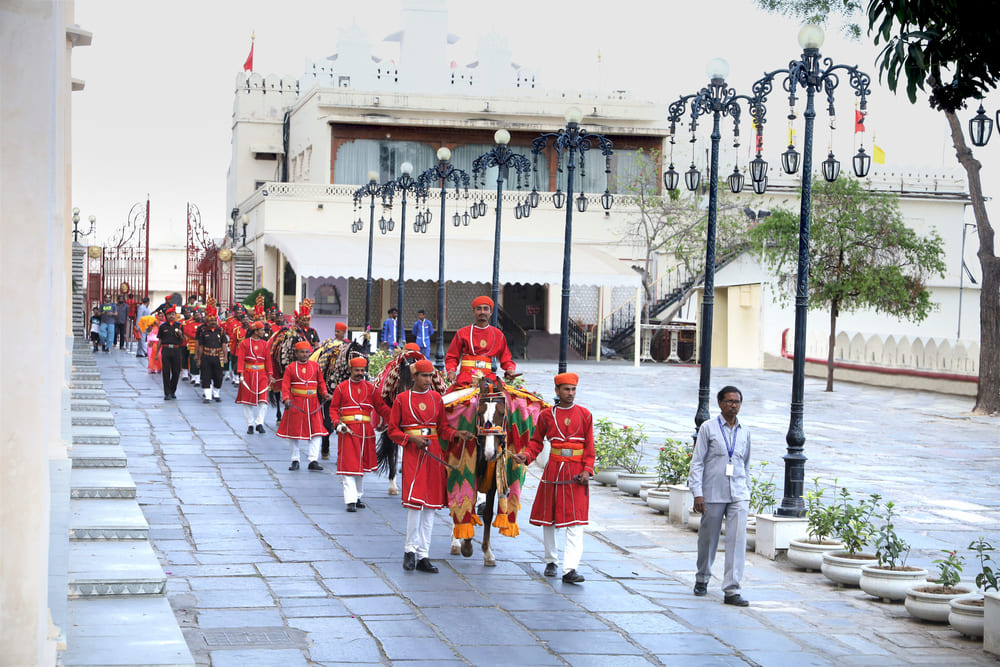
Gangaur Festival
-

In Mewar the Maharana would celebrate the Gangaur Mataji festival with public participation and besides being a religious festival it was a festival for good relations and for unity of the community. According to the Hindu calendar, on the date of Chetra Tritya in the bright moon period the first day celebrations would take place at Gangaur Ghat, also known as Raj Ghat on the banks of Lake Pichola. According to the daily diaries of the Maharanas, (Haqiqat bahidas), they would first visit the Zenana mahal, where the Gangaur Mata was donned with her festival attire and ornaments. The Maharana after worship would offer some bhet and then when the third drum beat was heard, he would mount his elephant from the Manek Chowk and in procession, with a elephant bearing his standard, Nissan, along with the Insignias of state, followed by nobles of Mewar, court officials, bards, military contingent, he would proceed to Roop Ghat (now Pipli Ghat). Simultaneously guns-salutes were fired from the Eklingarh Fort. From Roop Ghat the royal procession would come to Raj Ghat by boat where the Gangaur Mataji of different community would also have arrived there. There the Maharana would sit on a high pedestal in the boat accompanied by his nobles and court officials.
After enjoying a boat excursion on Lake Pichola the Maharanas boat would return back to Gangaur Ghat, where Maharana was profusely garlanded and after that garlands were distributed to the nobles and court officials. Then the Palace Gangaur Mataji accompanied by insignias of state would also arrive at Gangaur Ghat. There she was worshipped and the Daroga of Zenani Deodhi would take the Aashka to the Maharana, who would stand up and after with folded hands would offer prayers to Gangaur Mataji and give permission to return to the Palace in procession. For four days the city was in festival mood and the celebrations would include singing and dancing at Gangaur Ghat by city maidens. In Mewar according to tradition, every day the colour of the attire would be changed by the Maharana and the nobles and the public would also wear the same colour attire, like Chundai (Tie and Dye) attire, Green attire, Pink attire and crimson attire.
During the times of Maharana Fateh Singh (r. 1884 – 1930 CE), he decided in 1889, that the Palace Gangaur Mataji would not be taken to Gangaur Ghat, but instead will be taken to Paravti Vilas Ghat inside the Palace for worship and return back to the Palace from there. The Maharana while on excursion on Lake Pichola would visit Paravti Vilas Ghat and worship the Gangaur Mataji there. After the day’s festivities the Maharana would be carried back to the Palace in a Sedan Chair from the Ghat. On the occasion of Gangaur festival many Rajas and Maharajas from different states would visit Udaipur and the British officers would also come to see this celebrations.
During Gangaur festival the custom of Savera, Poojan and singing of songs;
According to the religious faith of the common man it is believed that by keeping fast the young maidens get a good husband and that the married women fast for the long life of their husbands. In Mewar after Holika Dahan the preparations for Gangaur festival are started. The maids go and collect the ashes from Holika Dahan and make pind and they are worshiped for seven days. From potter the maidens go and get clay and make idols of Gangaur and her consort Isaarji. The maidens at the time of worshipping Gangaur decorate them lavishly with expensive attire and ornaments.
In Mewar on the day of Gangaur worship the young maids wearing beautiful attire, carrying small pitchers of water go to the various gardens, fill the pitchers with flowers and singing religious songs bring them for Gangaur Mataji.
Dhingia Gangore;
In Mewar on Vaishakh Tritya, period of dark moon, the festival of Gangaur-Teej is celebrated. This festival is only celebrated in Mewar and nowhere else. In Mewar dialect Dhingia means doing something forcefully. It is said that to make his young Rani happy, Maharana Raj Singh I, (r. 1652 -1680 CE), started this festival. It became famous with the name of Dhingia Gangaur.
It is still continued today as part of the legacy.

